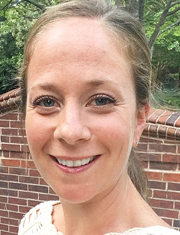
Beth Rosenbleeth started a blog called Days With Grey to incorporate many of the skills she learned in her days as an early childhood educator. Launched in April 2016, the blog merges motherhood — Grey is her preschool-age son — with education, offering small ideas to prepare children for kindergarten.

Beth Rosenbleeth's blog focuses on areas where play and education come together for preschool children.
Focusing on the Reggio Emilia philosophy
Rosenbleeth has over 13 years of teaching experience, certification in K-12, and a master’s in teaching reading. She’s a fan of the Reggio Emilia approach to early learning. How does it work?
It’s not a method, said Rosenbleeth. “You do not follow a curriculum or strict guidelines. Each class is uniquely taught through the student’s individual needs and curiosity.”
That approach can be a good fit in preschool, but it’s tougher to implement after kindergarten. “Elementary educators have high demands with grading and reaching specific benchmarks,” said Rosenbleeth. “They do not often have the time to teach through exploration and observation as they let the student be in control of their own learning.”
Encouraging exploration and growth
The Reggio approach requires giving children room to explore and grow. Rosenbleeth said educators must pay close attention to a student’s interactions and engagement with materials and continue their teaching based on their observations.
With traditional elementary education, Rosenbleeth said, teachers are expected to race through their courses to cover the required materials by the end of the school year. Most traditional schools also require a grading system that rates a child’s level of mastery. This again, she said, is not cohesive with a Reggio approach to learning.
Still, elementary educators can use elements of the Reggio approach by creating a more homelike environment. Using natural lighting and natural materials can help infuse Reggio into the traditional classroom.
The Reggio approach is easier to apply to preschools, early education and home settings. “At this time, children are forming an understanding of themselves and usually follow a typical play schema or pattern,” said Rosenbleeth. “They are using their environment as a ‘third teacher.’ Parents and early educators can play the role of a mentor or guide as the preschooler discovers, asks questions and makes observations.”
Getting preschoolers ready for kindergarten
Rosenbleeth suggests early-learning teachers focus on a few key principles when they introduce kindergarten learning standards benchmarks into their preschool-centered activities:
- Make sure you know what children need to master in kindergarten. “This does not mean preschooler educators should be teaching the kindergarten curriculum. It means preschool educators are aware of where the students need to be and will advance, or reteach, the student according to their individual needs,” she said.
- Acknowledge that learning and play cannot be separated. There are many languages of learning, especially on the preschool level.
- Look for ideas that are efficient, requiring few supplies and minimal setup. Focus on what you have and turn recycled materials into an opportunity for learning.
She also focuses many of her activities around the Reggio Emilia approach to learning through the different schemas of play. Teachers should watch students carefully as they play, Rosenbleeth recommends. Do they like to transport items? Transform items? Is that student excited about trajectory, rotating objects or connecting?
Also think about the function and accessibility of their space. Do they have a space that provokes exploration?
Most of Rosenbleeth’s blog posts match up with standards for kindergarten, which helps provide an understanding of what will be expected of children as they move beyond preschool.
Bringing play and learning together
Rosenbleeth urges teachers to find an educational rationale in everyday playful moments.
“We love being outside, and often find ways to incorporate future kindergarten benchmarks into what we are already doing. When we go for walks, we stop to talk about the different shapes of street signs,” she said.
“We talk about the amount of sides the shape may have, and what the sign may mean. We read the trail maps on hikes. The goal is to encourage exploration and guide your preschooler with extensions to their play.”
Erin Flynn Jay is a writer, editor and publicist, working mainly with authors and small businesses since 2001. Erin’s interests also reach into the educational space, where her affinity for innovation spurs articles about early childhood education and learning strategies. She is based in Philadelphia.